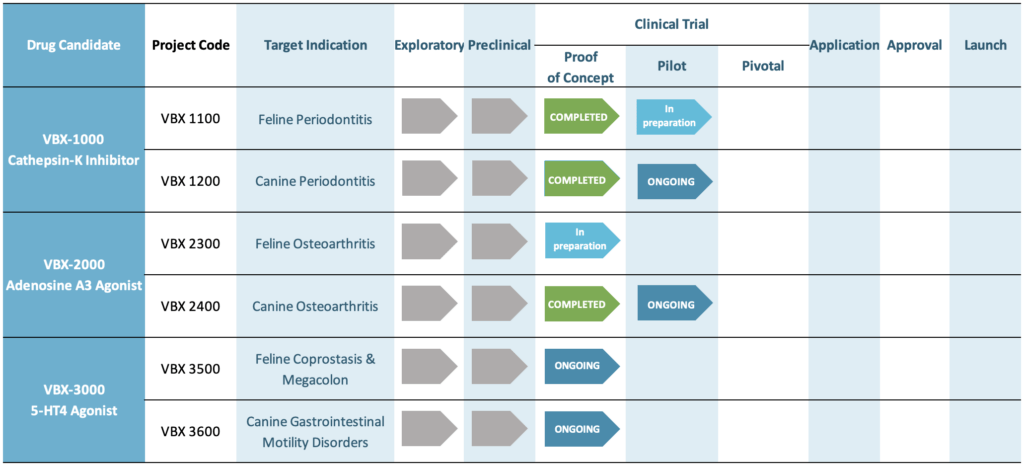Lille (France), April 15th 2024 – VETBIOLIX, a veterinary biotechnology company dedicated to the clinical development of First-in-Class drug candidates for the treatment of periodontal disease, osteoarthritis and gastric motility disorders in dogs and cats, announces the first positive results of the Proof of Concept Clinical study of its drug-candidate VBX-1000 (as known as MIV-701), the first specific inhibitor of cathepsin-K, for the treatment of periodontal disease in dogs.
The VBX1200-CL-1001 POC study Proof of Concept (PoC) clinical study was an open, multicenter, European study (France, Poland) seeking to evaluate the safety and efficacy of repeated oral administration of the drug candidate VBX-1000 for 90 days on different parameters of periodontal disease in dogs. This open-label clinical PoC study included a total of 20 dogs suffering from periodontal disease affecting at least three teeth. After scaling and polishing of the teeth, the dog patients were randomly divided into two groups. Group 1 was treated with the product VBX-1000 at a daily dose of 25 mg/kg orally for 60 days. If at the end of this period, the dose of 25 mg/kg/day was well tolerated, a daily dose of 50 mg/kg of VBX-1000 was administered for the following 30 days. Group 2 was treated with VBX-1000 at a daily dose of 50 mg/kg orally for 90 days. The primary objective of the study was to investigate the effects of VBX-1000 on plasma CTX1 concentration after 90 days of treatment. CTX1 comes from bone degradation (resorption) resulting from the activity of Cathepsin-K produced by specialized cells (i.e. osteoclasts). The other objectives of the study focused on the evolution after 90 days of treatment of two essential clinical parameters of periodontal disease measured on a total of 60 teeth (3 teeth/dog; 20 dogs): the CAL (Clinical Attachment Loss) and the PPD (Periodontal Probing Depth). Finally, the evolution of the alveolar bone defect after 90 days was documented on 60 teeth affected by periodontal disease using two distinct imaging techniques: X-ray radiography and CBCT (Cone Beam Computed Tomography). In both groups, repeated administration of VBX-1000 was well tolerated. No deaths and no serious adverse events attributable to treatment were reported. Given the very good tolerance to the dose of 25 mg/kg/day, all dog patients in group 1 received a daily dose of 50 mg/kg during the last 30 days of treatment. The primary efficacy endpoint was met. After 90 days, the plasma concentration of CTX1 in both groups was significantly reduced compared to the value before treatment (see Table 1 below). At the intermediate visits on D30 and D60, the decreases in CTX1 were similar in the two groups. In the entire population (n=20 dogs) the relative decrease after 90 days (D90-D0) was -59% (median value ; 95% CI : -75 ; -45 %).
Table 1
| Plasma CTX-1(ng/mL) |
Jour 0Pré-traitement |
Day 30 |
Day 60 |
Day 90 |
P value$D90 vs D0 |
| Group 1 |
N (patients) |
10 |
9 |
10 |
10 |
|
| Dose |
|
25 mg/kg/d |
25 mg/kg/d |
50 mg/kg/d |
|
| Mean±SD |
0,27±0,23 |
0,06±0,01*** |
0.08±0,04* |
0,10±0,04 |
P=0,004 |
| Group 2 |
N (patients) |
10 |
9 |
9 |
10 |
|
| Dose |
|
50 mg/kg/d |
50 mg/kg/d |
50 mg/kg/d |
|
| Mean±SD |
0,26±0,17 |
0,09±0,04* |
0,09±0,06* |
0,09±0,05 |
P=0,03 |
| Gr1 + Gr 2 |
N (patients) |
20 |
NA |
NA |
20 |
|
| Mean±SD |
0,26±0,20 |
NA |
NA |
0,10±0,04 |
P=0,0002 |
$ p value D90 vs D0 according to « Wilcoxon matched-pairs signed rank test ».*p<0,05 ; ***p<0.001 vs D0 according to « Dunn’s multiple comparisons test »
The rapid and continued decrease of CTX1 plasma concentration suggested persistent inhibition of the resorption process that may promotes bone healing around affected teeth. In support of this hypothesis, the comparison of radiographs before and after treatment showed a statistically significant decrease in width (n=60 teeth; 3 teeth/dog; p<0.0001) and depth (n=60 teeth, 3 teeth/dog, p<0.05) of the bone defect existing between the root of the tooth and the maxillary bone. These results were further confirmed in ten dogs (30 teeth) examined by CBCT imaging. Finally, two reference measures used in clinical practice to assess the severity of periodontal disease were significantly improved. On D90, the CAL was reduced on average by 0.99mm compared to D0 (95% confidence interval from -1.27 to -0.70 mm; n=60; p<0.0001). Likewise, the PPD was reduced by 0.98 mm (95% confidence interval from -1.24 to -0.72 mm, n=60, p<0.0001).
Rémy Hanf, Founder and CSO of VETBIOLIX – Board member said: « This first Clinical Proof-of-Concept study of VBX-1000 in periodontal disease in dogs met all our expectations. The results are all in the same direction, suggesting that the oral VBX-1000 product reaches its molecular target, inhibits cathepsin-K activity, promotes alveolar bone healing and regression of periodontal disease. The full results will be detailed in a scientific publication currently being written. Building on the confidence these results give us, we are working with our experts in the field to set up Q4-2024 a regulatory Pilot clinical study seeking to strengthen the demonstration of the effects of VBX-1000 in a double blind, randomized, placebo-controlled clinical trial in dogs. »
Matthieu Dubruque, Founder and Managing Director of VETBIOLIX added: « This is an important milestone for VETBIOLIX and we are of course very satisfied of these first clinical results. Periodontal disease is one of the leading causes of veterinary consultations for dogs and cats. These first results in dog patients support our entrepreneurial model and demonstrate the ability of VETBIOLIX to deliver rewarding clinical results. Likewise, we are expecting the results of clinical proof of concept studies for 4 other programs in our portfolio by the end of 2024: VBX-1100 in periodontal disease in cats, VBX-2400 in osteoarthritis in dogs, VBX-3500 and VBX-3600 in gastrointestinal motility disorders in cats and dogs. »
Matthieu Roquette, Founder and President of VETBIOLIX said: « These very encouraging results reinforce our determination to continue the development of our drug candidate VBX-1000 in periodontal disease in dogs. To lead the next stages of development of VBX-1000 and our products portfolio as a whole, the team must gradually strengthen. The recent arrival of Dr Karine Bertrand as Chief Pharmaceutical and Technical Officer – Board Member in charge of the pharmaceutical development of our products obviously contributes to the confidence we have in achieving our objectives. »
About VETBIOLIX– https://www.vetbiolix.com
VETBIOLIX develops innovative products for the treatment and prevention of diseases affecting pets. VETBIOLIX has built a unique pipeline of First-in-class small molecules in-licensed (exclusive and worldwide license) from Human Biotech worldwide which will answer to veterinary unmet medical needs in periodontitis, osteoarthritis and gut motility disorders. VETBIOLIX focuses exclusively on clinical developments of its drug candidates: the company invests on (i) clinical proof of concept studies, (ii) CMC-Pharmaceutical developments, (iii) regulatory Pilot clinical studies and (iv) regulatory Pivotal clinical studies. Revenue generation of the company will be based on out-licensing and/or co-developments deals with the Veterinary Pharmaceutical Industry.
Since mid-2022, VETBIOLIX has been conducting multicenter European Proof of Concept clinical studies on dog patients and cat patients with its most advanced drug candidates:
– VBX1000: Proof of Concept clinical studies of a Cathepsin-K inhibitor in dog patients (VBX1200-CL-1001 PoC study) and cat patients (VBX1100-CL-1001 PoC study) suffering from periodontitis
– VBX2000: Proof of Concept clinical study of an Adenosin-A3 agonist in dog patients (VBX2400-CL-1001 PoC study) suffering from osteoarthritis
– VBX3000: Proof of Concept clinical studies of a new generation 5-HT4 agonist in dog (VBX3600-CL-1001 PoC study) and cat patients (VBX3500-CL-1001 PoC study) suffering from gastric motility disorders
Contact: matthieu.dubruque@vetbiolix.com






